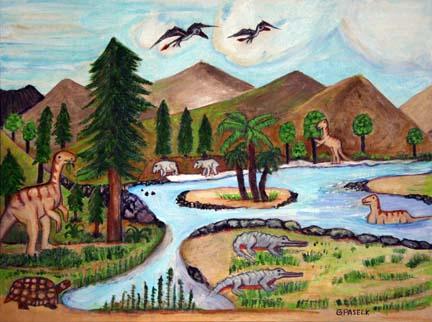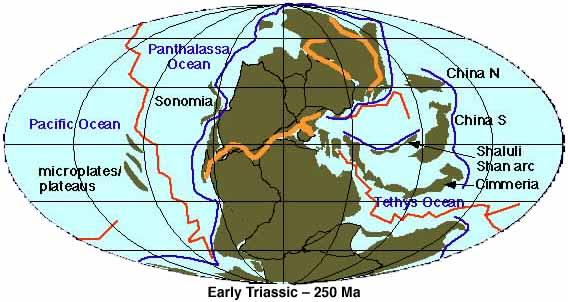
Late Triassic Landscape
© G. Paselk
251.0 to 199.6 Million years ago
Richard Paselk
Plate Tectonic Reconstructions

These maps of major tectonic elements (plates, oceans, ridges, subduction zones, mountain belts) are used with permission from Dr. Ron Blakey at Northern Arizona University. The positions of mid-ocean ridges before 200 Ma are speculative. Explanation of map symbols.
Triassic* flora and fauna differ significantly from the Permian biota lost to the greatest extinction event of the Phanerozoic Eon. The differences in Permian and Triassic biota are so great that they also mark the transition between the Paleozoic and the Mesozoic Eras. The Permian extinctions were so extensive and deep that the early Triassic saw a return to a Precambrian-like ecology. Microbes dominated these early ecologies, with microbial reefs occuring in the earliest Triassic. Stromatolites became widespread for the first time in 400 million years. Both in the sea and on land the early Triassic biota are dominated by limited diversity opportunistic fauna and flora. As an example, vast beds of a near monoculture of the scallop Claria were deposited in the seas of what is now Utah. On land lycopsids dominanted the low-diversity flora, with other opportunistic species such as quilworts unusually common. It took nearly four million years for ocean biotic diversity to recover, while on land it was not until the middle Triassic that conifer dominated forests finally displaced the lycopsids. As we approach the end of the Triassic, dinosaurs began their dominance of terrestrial ecosystems.
The Triassic ended in a significant extinction event with about 25% of all animal families disappearing. Ammonites were reduced to a single genus dispite their rapid and extensive diversification in the early Triassic. Brachiopods were devastated once again, and nearly all land reptile and amphibian families were lost.
Geologically and climatically the Triassic is a time of relative quiet in Earth history. An apparent catastrophic loss of plant life may have lead to global warming and a transition from meandering to braided rivers (charecteristic of distrurbed environments) during th eearly Triassic. There are no known glaciations during this Period on the supercontinent of Pangea.
*The Triassic comes from the Trias of von Alberti (1834) which united three southern German formations.
Triassic Animal (Metazoan) Fossils
Echinoderms (ToL: Echinodermata<Deuterostomia<Bilateria<Metazoa<Eukaryota)

Crinoids
Echinoderms recovered slowly in the Triassic. Two examples of crinoid stem pieces (stem stars) from Pentacrinus californicus are displayed:
Pentacrinus californicus
Reptilia (ToL: Vertebrata<Chordata<Deuterostomia<Bilateria<Metazoa<Eukaryota)

Reptiles
Reptiles (Reptilia): The Triassic begins the Mesozoic Era, also known as the Age of Reptiles. Reptiles diversified tremendously during this Period, filling many of the empty niches on land and in the sea. Two marine reptiles are represented in the Triassic display: a Keichosaurus and a specimen of Phytosaur teeth.
Phytosaurs had a crocodilian appearance, but were not closely related. They appear in the Late Triassic and become extinct with the end of the Triassic.
 Phytosaur teeth
Phytosaur teeth ![]() life reconstruction
life reconstruction
Keichosaurs were highly aquatic probably fish-eating reptiles. They appear to have given live-birth rather than being egg-layers, thus avoiding leaving the water for reproduction.
![]() Keichosaurus
Keichosaurus ![]() life reconstruction
life reconstruction
Mollusks (ToL: Mollusca<Lophotrochozoa<Bilateria<Metazoa<Eukaryota)

Gastropods
Gastropods (Gastropoda): The tiny black dots visible on this slab (link below) of sheared, recrystallized limestone are internal casts (steinkerns) of microgastropods. Early Trissic (pre-recovery) fossil deposits typically consist of such low diversity assemblages of miniature organisms following the great Permian extinctions. Magnified views, such as the macrophotos linked below, show the coiled body shape of these tiny (approximately 0.5 mm dia.) organisms.
![]() Limestone slab
Limestone slab Close-up with mm scale
Close-up with mm scale
![]() Macro 1-wide field
Macro 1-wide field  Macro 1-close view, center of field
Macro 1-close view, center of field  Macro 2-close view
Macro 2-close view
Cephalopods
(Cephalopoda): The single family of ammonoids surviving the Permian extinction appears to be the first group to recover in the Triassic. They quickly diversified to about 400 genera. Ammonites on display include:
![]() an assemblage of Ceratites humboldtensis
an assemblage of Ceratites humboldtensis
![]() ammonoid and orthocone nautiloid
ammonoid and orthocone nautiloid
Corals (ToL: Cnidera<Metazoa<Eukaryota)
Corals
Cnidarians (corals): The extinction of the Paleozoic coral families resulted in a slow recovery of this group during the Triassic. The Scleractinian family, the first modern corals, appear in the Middle Triassic. Moderrn corals represent new newly skeletonized groups, apparently evolving from soft-bodied organisms during the early Triassic.
Triassic Plant Fossils
Vascular Plants (ToL: Embryophytes [land plants] <Green Plants<Eukaryota)

Conifers
The Permian extinction affected plants as well as animals. It wan't until the middle Triassic that conifers displaced the early, opportunistic, low-diversity, post-Permian extinction flora dominated by lycopsids. The petrified conifer wood on display is from the famous Petrified Forest of Arizona.
The engravings of Triassic fossils are from Dana, James D. (1870) Manual of Geology; Le Conte, Joseph (1898) A Compend of Geology; Shimer, Harvey Woodburn (1914) An Introduction to the Study of Fossils, or Louis Pirson and Charles Schuchert (1920) A Text-Book of Geology.
©1998, Cal Poly Humboldt NHM | Last modified 30 October 2012


 slab 1
slab 1
 Beyrichites deleeni
Beyrichites deleeni unidentified ammonoid
unidentified ammonoid Scleractinian
Scleractinian petrified conifer wood
petrified conifer wood